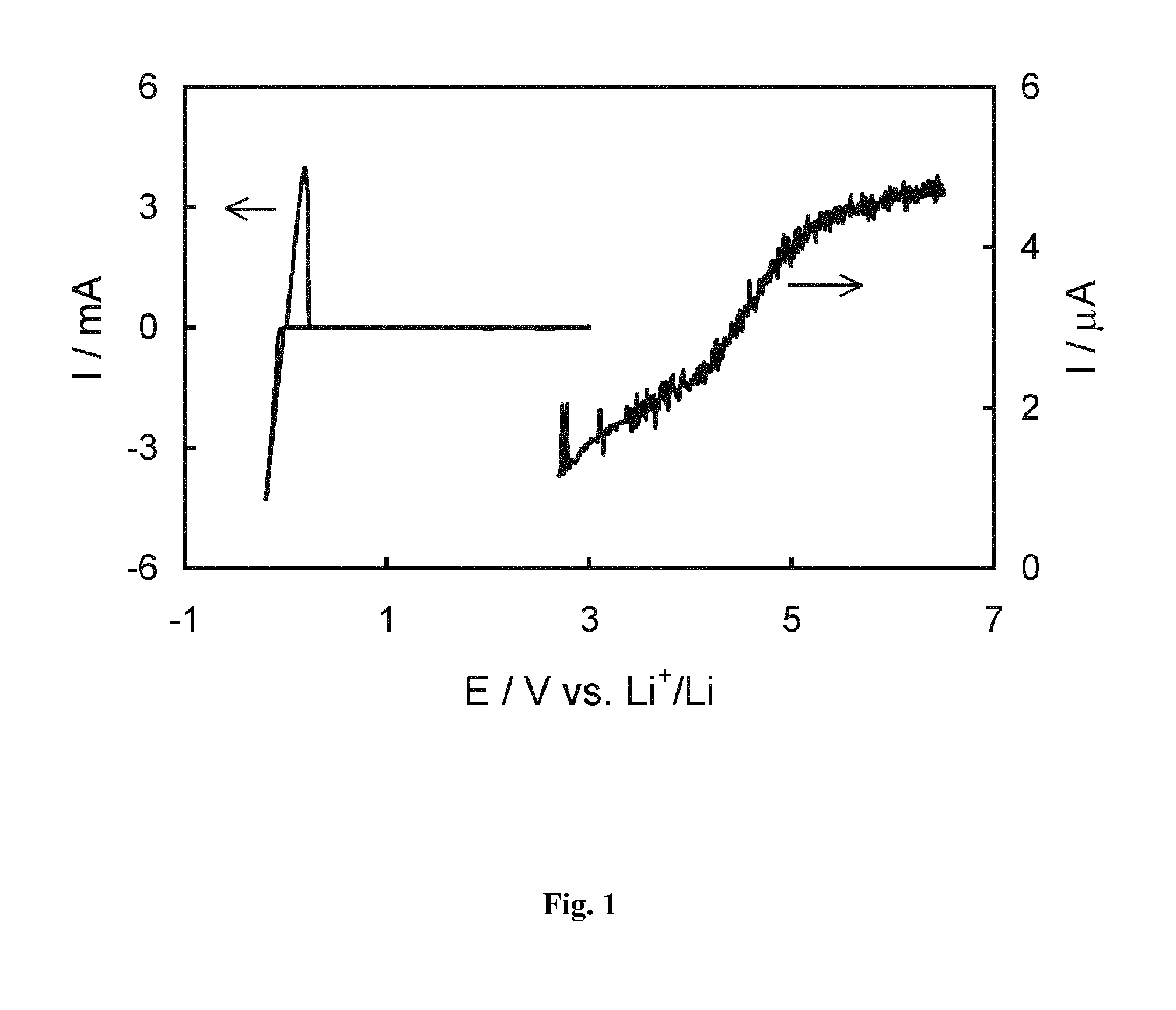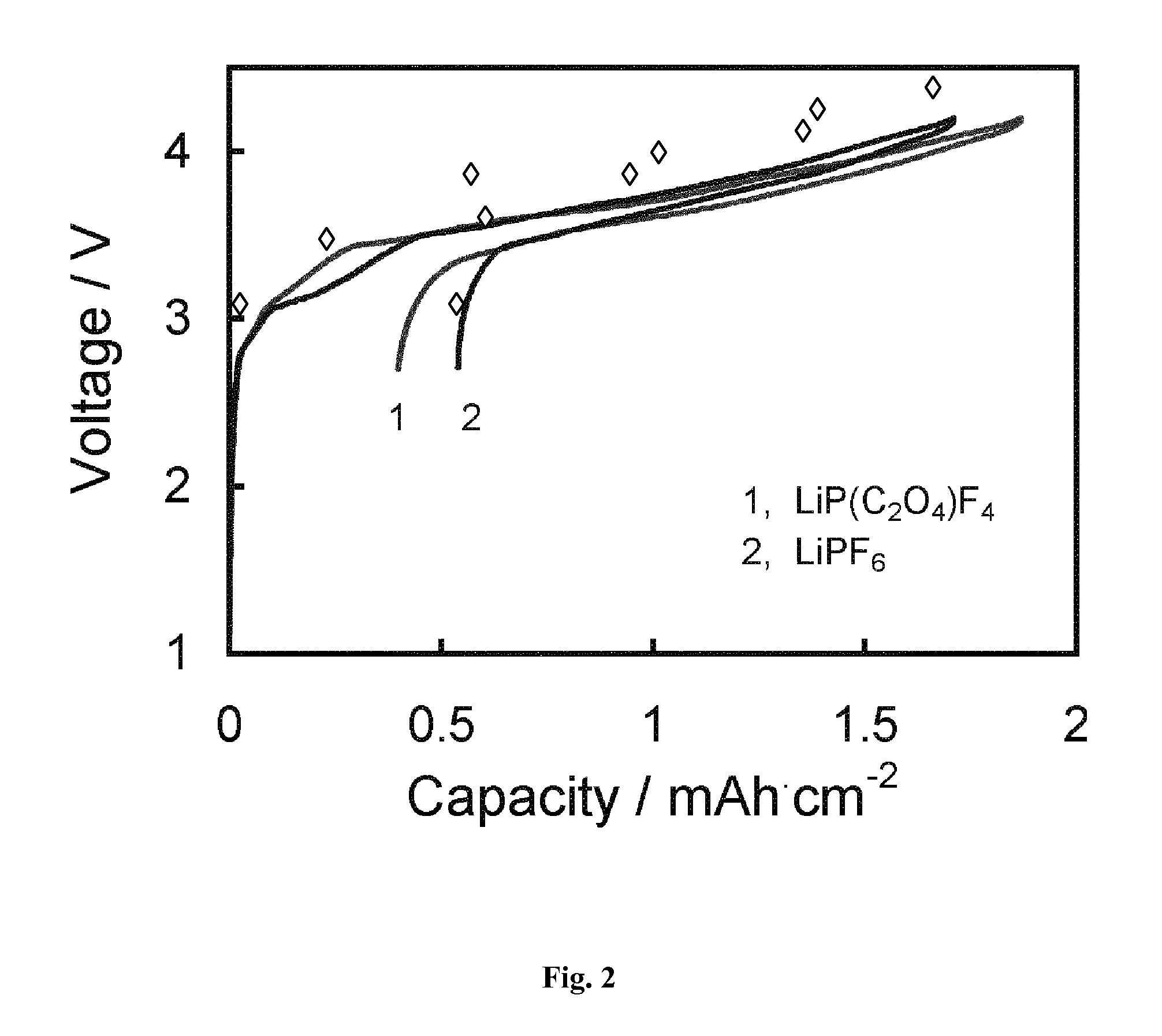Oxyfluorophosphate synthesis process and compound therefrom
a technology of hexafluorophosphate and synthesis process, which is applied in the direction of organic compounds, chemical apparatus and processes, group 5/15 element organic compounds, etc., can solve the problems of hexafluorophosphate hydrolysis not only affecting the safe handling of lithium ion batteries, and degradation of transition metal oxides
- Summary
- Abstract
- Description
- Claims
- Application Information
AI Technical Summary
Benefits of technology
Problems solved by technology
Method used
Image
Examples
example 1
Synthesis of lithium oxalylfluorophosphates (LiOFP) including lithium oxalyltetrafluorophosphate (LiOTFP), lithium dioxalyldifluorophosphate (LiDODFP) and lithium trioxalylphosphate (LiTOP)
[0037]With exclusion of moisture, a Schlenk flask containing 45.6 g (0.3 mol) of LiPF6 was heated at 180-200° C. to quantitatively produce PF5 gas. The gas was transferred from the generator flask through a tube line to a reaction flask containing 30.6 g (0.3 mol) of lithium oxalate (Li2C2O4) and 250 mL of acetonitrile and allowed to react with stirring for two hours. The resulting mixture was filtered and evaporated under a reduced pressure and further dried at 80-90° C. under vacuum for six hours to obtain a crude product. The crude product was purified by recrystallization using a 1:1 by volume ratio of acetonitrile to dimethyl carbonate. After drying for 16 hours under vacuum at 90° C., LiOTFP with high purity was obtained and identified by NMR spectroscopy as being LiP(C2O4)F4. By changing th...
example 2
Synthesis of lithium glycoltetrafluorophosphate (LiGTFP), lithium diglycoldifluorophosphate (LiDGDFP) and lithium triglycol phosphate (LiTGP)
[0038]With exclusion of moisture, a Schlenk flask containing 45.6 g (0.3 mol) of LiPF6 was heated at 180-200° C. to quantitatively produce PF5 gas. The gas was transferred from the generator flask through a tube line to a reaction flask containing 28.8 g (0.3 mol) of lithium methoxyacetate (CH3OCH2CO2Li) and 250 mL of acetonitrile and allowed to react with stirring until getting a clear solution or for two hours. The resulting mixture was filtered and evaporated under a reduced pressure and further dried at 80-90° C. under vacuum for six hours to obtain a crude product. The crude product was purified by recrystallization using a 1:1 by volume of acetonitrile / dimethyl carbonate solvent. After drying for 16 hours under vacuum at 90° C., LiGTFP with high purity was obtained and identified by NMR spectroscopy as being LiP(OCH2CO2)F4 (LiGTFP). By ch...
example 3
Synthesis of LiOTFP or LiDODFP or LiTOP in the Absence of a Solvent
[0039]With exclusion of moisture, 45.6 g (0.3 mol) of LiPF6 and 30.6 g (0.3 mol) of lithium oxalate (Li2C2O4) were ground together, then sealed in a pressure vessel and heated at 150-180° C. for 1 hour. The resulting mixture was reground and extracted with 250 mL of acetonitrile. The resulting solution was evaporated under a reduced pressure and further dried at 80-100° C. under vacuum for six hours to obtain a crude product. The crude product was purified by recrystallization using a 1:1 by volume of acetonitrile / dimethyl carbonate solvent. After drying for 16 hours under vacuum at 90° C., LiOTFP with high purity was obtained and identified by NMR spectroscopy as being LiP(C2O4)F4 (LiOTFP). By changing the ratio of LiPF6 to Li2C2O4, LiP(C2O4)2F2 (LiPF6 / Li2C2O4-1:2 in mol) and LiP(C2O4)3 (LiPF6 / Li2C2O4=1:3 in mol) also can be readily synthesized.
PUM
| Property | Measurement | Unit |
|---|---|---|
| temperatures | aaaaa | aaaaa |
| temperatures | aaaaa | aaaaa |
| temperature | aaaaa | aaaaa |
Abstract
Description
Claims
Application Information
 Login to View More
Login to View More - R&D
- Intellectual Property
- Life Sciences
- Materials
- Tech Scout
- Unparalleled Data Quality
- Higher Quality Content
- 60% Fewer Hallucinations
Browse by: Latest US Patents, China's latest patents, Technical Efficacy Thesaurus, Application Domain, Technology Topic, Popular Technical Reports.
© 2025 PatSnap. All rights reserved.Legal|Privacy policy|Modern Slavery Act Transparency Statement|Sitemap|About US| Contact US: help@patsnap.com



